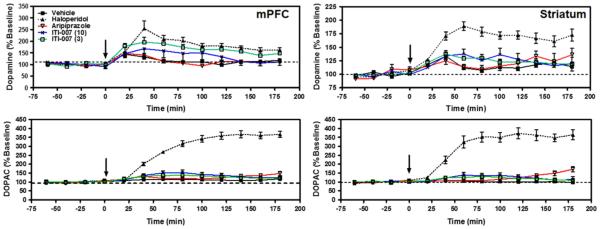Fig. 7.

Effect of acute administration of haloperidol, aripiprazole, or ITI-007 on extracellular dopamine and DOPAC levels in rat striatum and medial prefrontal cortex, as measured by in vivo microdialysis. Adult, male Wistar rats were surgically prepared with microdialysis probes for collection of dialysate from both medial prefrontal cortex (mPFC) and striatum. Following establishment of baseline DA and DOPAC levels, the rats received (at t=0 min, designated by arrow) an acute dose of vehicle solution (0.5 % methylcellulose in water, 1 ml/kg volume, p.o.; N=8–9 rats; filled box), haloperidol (0.3 mg/kg in acidified water, 1 ml/kg, s.c.; N=6–10 rats; filled triangle), aripiprazole (30 mg/kg, p.o.; N=5–6 rats; open red triangle), or ITI-007 (3 or 10 mg/kg, p.o.; N=6–10 rats each; open green box and cross, respectively). Striatal and mPFC dialysates were collected every 20 min for 3 h for measurement of dopamine (top panels) and DOPAC (bottom panels). Analysis of variance with Newman–Keuls post hoc tests revealed significant effects, compared with vehicle control, of haloperidol on DA efflux in mPFC (p<0.01) and striatum (p< 0.001) and DOPAC efflux in mPFC and striatum (p<0.001). ITI-007 (3 mg/kg) induced a significant increase in DA efflux, compared to vehicle control, in mPFC (p<0.05). The increase in DA efflux in mPFC induced by ITI-007 (3 mg/kg) was significantly larger than that induced by aripiprazole (30 mg/kg) (p<0.05)
